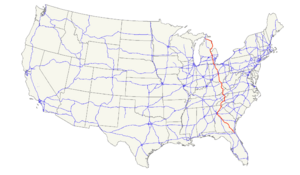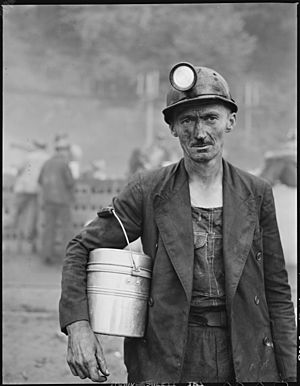Hillbilly Highway facts for kids
The Hillbilly Highway is a name for a large movement of people. These people moved from the Appalachian Mountains to big cities in the north, midwest, and west of the United States. This happened mostly after World War II. People were looking for better jobs in factories. They also wanted a better way of life. Many of these people used to work in coal mines. But the coal industry started to slow down in the 1940s.
The word hillbilly is sometimes used to describe people from Appalachia. It can be a negative stereotype. The term "Hillbilly Highway" is similar to the Great Migration. That was when many African-Americans moved from the South.
Many Appalachian people moved to big industrial cities. Some of these cities were Detroit, Chicago, Cleveland, and Cincinnati. Others went to Pittsburgh, Baltimore, and Washington, D.C.. Some even traveled west to California.
Many Appalachians lived close together in certain areas. For example, Uptown, Chicago was called "Hillbilly Heaven" in the 1960s. The term "Hillbilly Highway" usually means this big movement of people. But sometimes it refers to actual roads. These include U.S. Route 23 or Interstate 75. People who took part in this move are sometimes called Urban Appalachians. This migration is still happening today. Many people often move back home when they retire. Or they might move away only for a short time.
Contents
Understanding Appalachia
The Appalachia region covers all of West Virginia. It also includes parts of Alabama, Georgia, and Kentucky. Other states are Maryland, Mississippi, North Carolina, and Ohio. It also includes parts of Pennsylvania, South Carolina, Tennessee, and Virginia. This large region has 420 counties across 13 states.
Appalachia is often divided into three main parts: northern, central, and southern. There are at least 31 mountains in the Appalachian region. The Appalachian Regional Commission was created in the 1960s. This group helps with economic growth and building better infrastructure. They work to reduce poverty and unemployment in the area.
In 2007, the Commission said that 78 counties in 9 states were "distressed." This meant they had low incomes and high rates of poverty. Some of these areas still needed basic things like water and sewer systems. For example, in Breathitt County, Kentucky, many adults did not have high school diplomas in 2000.
The Role of Coal Mining
Coal mining has always been a very important part of Appalachia's economy. West Virginia is one of the biggest coal-producing states in this region. A unique part of Appalachian coal mining was the "company towns."
In these towns, the coal companies owned everything. They owned the houses, stores, and even provided services. Workers often used "company scrip" instead of regular money. Prices in these stores were often very high. Some towns were in very bad condition.
Over time, workers fought to form unions. These struggles happened from the 1890s to the 1940s. They fought again from the late 1970s to 1999. Sometimes, these fights turned into serious conflicts. These were called "mine wars." The companies tried to stop workers from joining unions. They even brought in other workers to break strikes. The story of coal miners forming unions in Appalachia is long and complicated.
Why Miners Moved North
Coal prices were not always stable, especially after World War I. Also, there were ongoing struggles between miners and companies. Because of this, many miners decided to leave the coal industry. They moved north to find new jobs. This move became known as the Hillbilly Highway.
After World War II, big factories like General Motors started hiring many people. About seven million people moved north for these jobs. White workers often went to areas in Ohio and Pittsburgh. African-American workers often moved to Detroit and Baltimore. The singer Steve Earle even wrote a song called "Hillbilly Highway." It was on his 1986 album Guitar Town.
Appalachian Migration Patterns
Moving away has been a big part of life for Appalachian people. Many people left Appalachia in the 20th century. They moved for economic reasons, meaning they needed better jobs and money. Between 1910 and 1960, millions of people left states like Tennessee, Kentucky, the Carolinas, Virginia, and West Virginia.
A large number of people from Kentucky, West Virginia, and Tennessee went north. They found jobs in factories and industries. Many West Virginians and Kentuckians moved to industrial cities in Ohio. They worked in rubber and steel factories. Cities like Dayton and Cincinnati were popular. They were close enough to home for migrants from Eastern Kentucky.
Some companies in Ohio even recruited workers directly from specific counties in the mountains. They often preferred to hire family members of current employees. This made it easier for people to leave rural Appalachia and find work.
Life in Detroit
In the 1930s, car factories in Detroit thought Appalachian workers were "safe." This meant they believed these workers would not join unions. Companies recruited these rural people. They thought they had not been influenced by union ideas.
However, these "hill-billies" were often looked down upon by others. This was because they had a different way of life. They were also seen as taking jobs from older factory workers. But the new assembly lines in factories meant that workers did not need many skills. So, these new workers from the mountains were good employees. Bobby Bare had a popular song in 1963 called "Detroit City". It described how migrants often felt homesick and surprised by city life.
New Identities for Migrants
Appalachian people who moved to Detroit (and Flint) for factory jobs developed a new identity. They were different from who they were back home. Many families had to separate and get used to new places. This could be a difficult experience. They faced unfair treatment and negative stereotypes. These issues affected future generations too. Migrants often felt out of place. It was hard for them to feel like they belonged in their new communities.
Back home, people saw themselves as different from others in their own state. But once they moved to Michigan, they were all grouped together. They were seen as "southern white laborers." This created a new sense of group identity. Migrants from all over Appalachia started to feel connected to each other. They preferred to live and work with other Southerners.
It was thought that Appalachian migrants did not blend into city life as quickly as other rural migrants. This was because of their strong group identity. They also held onto certain southern attitudes. They were very aware of how different they were from other white Americans born in the North. When they faced new situations in northern cities, their reactions were based on their rural southern lives. During holidays and factory layoffs, many migrants would go back to their old homes. For example, during layoffs in Flint, Michigan, about 35% of migrants would return home.



